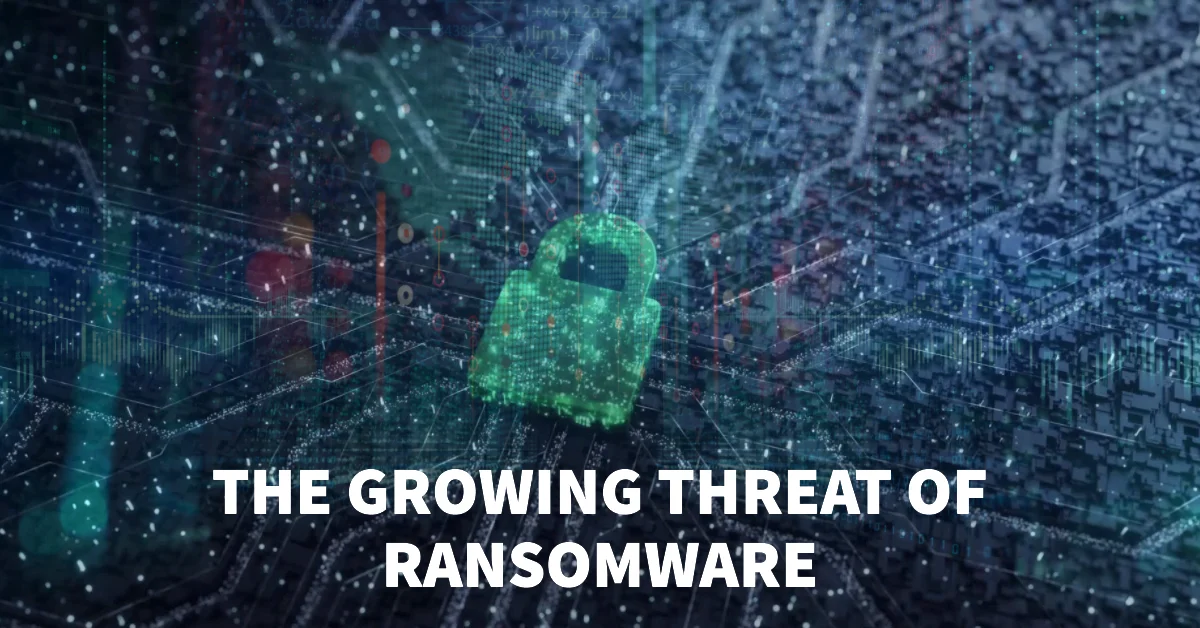
The Growing Threat of Ransomware and How to Protect Your Organisation
In today’s interconnected world, where digital data is more valuable than ever, the threat of ransomware is an ever-looming presence. As business owners and individuals managing a home office, it is imperative to understand why ransomware is such a threat to your organisation and take necessary steps to protect against ransomware.
Ransomware, a type of malicious software, holds your data hostage by encrypting it and then demanding a ransom to restore your access. The detrimental effects can range from temporary disruptions to severe losses in revenue and reputation. This article will provide insight into how you can mitigate the growing ransomware risks and present effective solutions against ransomware.
Understanding the Ransomware Threat
Before delving into the ways to prevent ransomware infection, it’s important to grasp why ransomware poses such a significant risk. First and foremost, ransomware attacks are profitable for criminals, and they continue to innovate their methods. Furthermore, with the shift to remote work, there are more potential vulnerabilities to exploit, thus making ransomware protection increasingly essential.
Secondly, ransomware attacks are not discriminative – they target both large corporations and small businesses, non-profit organisations, and even individual users. In fact, small to medium-sized businesses (SMBs) are often more attractive targets as they may lack the comprehensive IT security solutions of larger corporations.
Preventing Ransomware Attacks
Preventing ransomware attacks involves multiple layers of defence. Here are some strategies:
- Adopt robust IT security practices: Implementing robust security practices can greatly reduce the risk of a ransomware attack. This involves using reliable antivirus software, keeping your operating systems and software up-to-date, and using firewalls to block suspicious traffic. Businesses should also consider leveraging comprehensive IT support with RMM tools for proactive threat detection and management.
- Employee education: Human error is one of the leading causes of successful ransomware attacks. Regular training sessions to educate your team about the dangers of phishing emails, suspicious links, and ensuring they understand the importance of following safe online practices are vital.
- Regular backups: One of the most effective ways to mitigate the damage of a ransomware attack is to maintain regular backups of your important data. With services like Kwik Backup – Data Protection as a Service, you can ensure that your critical business data is safely stored and easily recoverable in the event of a ransomware attack.
- Use a Managed Service Provider (MSP): MSPs offer comprehensive IT solutions tailored to your business needs. From maintaining IT infrastructure to implementing cybersecurity measures, Managed Service Providers can significantly alleviate the burden of IT management and fortify your defences against cyber threats.
- Limit access controls: Not everyone in your organisation needs access to all your data. Implementing strict access controls can help minimise the potential damage in the event of a ransomware attack. Consider using Professional IT Management Services to help implement effective access control strategies.
Remember, the most robust security system can be undermined by a single weak link. Cybersecurity requires an ongoing commitment and a comprehensive approach, including awareness, prevention, detection, and response mechanisms. Implementing these measures can significantly improve your organisation’s resistance to ransomware attacks.
Addressing a Ransomware Infection
In the unfortunate event that your organisation falls victim to a ransomware attack, the first step is to isolate the infected systems to prevent the spread of the ransomware. Notify your IT department or contact an IT professional to begin the process of removing the ransomware.
Remember, it is crucial to have a disaster recovery plan in place. This plan should include steps on how to restore your systems from safe, reliable backups, to minimise downtime and data loss.
In Summary
As the digital landscape evolves, so too do the threats that come with it. Ransomware attacks show no sign of slowing down, emphasising the importance of a proactive approach to data protection and cybersecurity. With comprehensive prevention strategies, regular employee education, robust backup systems, and effective IT support, your organisation can stand strong against the growing threat of ransomware.
Emphasising the Importance of Ransomware Protection
Given the potential financial and reputational damages of a successful ransomware attack, the importance of ransomware protection cannot be overstated. Even small and medium enterprises (SMEs), which might believe they are not typical targets, should prioritise cybersecurity, as they often lack the defences of larger corporations, making them attractive targets for cybercriminals. By acknowledging the risks and acting accordingly, you can safeguard your business data and your organisation’s future.
Top 5 Ways to Protect Against Cyber Attacks
As business owners and individuals running a home office, here are the top five strategies you can employ to protect yourself from cyberattacks:
- Secure your networks: Use strong, unique passwords for all your accounts and enable two-factor authentication (2FA) wherever possible. You can also consider using a Virtual Private Network (VPN) for an additional layer of protection.
- Update and patch your systems regularly: Cybercriminals often exploit vulnerabilities in outdated software. Keeping your systems updated can help prevent these attacks. Regularly patching and updating your systems is a proactive approach that’s part of a larger strategy of comprehensive IT support.
- Implement a robust backup strategy: Regularly back up your important data and ensure it’s stored securely. Implementing a cloud backup solution like Kwik Backup – Data Protection as a Service ensures your data is safe and recoverable in case of a cyberattack.
- Educate your team: Equip your team with the knowledge to identify and avoid potential cybersecurity threats. This includes teaching them about phishing scams, the importance of not sharing sensitive information, and the risks of using unsecured networks.
- Invest in professional IT services: Professionals in the field can offer tailored solutions and ongoing support to help protect your organisation from cyber threats. Services like Managed Service Provider (MSP) offer comprehensive security solutions to mitigate risks.
Four Additional Ways to Prevent Cyber Attacks
Beyond the top five strategies, here are four additional steps you can take to further protect your organisation from cyberattacks:
- Implement network security tools: Employ firewall protections, Intrusion Detection Systems (IDS), and Intrusion Prevention Systems (IPS) to secure your network from threats.
- Secure your email systems: Email is a common entry point for cyberattacks. Use spam filters and encrypt sensitive emails to protect your data.
- Use secure configurations: Default configurations can be easy targets. Ensure your systems and applications are securely configured.
- Employ regular system audits: Regularly audit your IT systems for vulnerabilities. This includes conducting penetration testing and vulnerability assessments.
With the right measures in place, such as these, you can greatly reduce the risk of cyber threats.
Implementing Preventative Measures Against Security Threats
A comprehensive approach to cybersecurity includes implementing preventative measures to stop security threats before they can cause damage. This could involve things like using an antivirus solution, implementing a firewall, and regularly patching and updating systems.
Further strategies include implementing least privilege access, enforcing strong password policies, and educating employees about phishing and other social engineering tactics. These measures, combined with regular data backups and a robust disaster recovery plan, can make your organisation resilient in the face of cyber threats.
In Summary
To mitigate the growing risks associated with ransomware and other forms of cyberattacks, it’s crucial to take a comprehensive approach. With robust IT support, ongoing education, and an effective disaster recovery plan, your organisation can effectively navigate the online world. Cybersecurity isn’t a destination, but a journey that requires consistent vigilance and improvement. By recognising the importance of this process, you’re taking the first step towards ensuring the longevity and success of your organisation.
The Necessity of Ransomware Protection
Ransomware protection isn’t an option—it’s a necessity. With the rising sophistication of ransomware attacks and the damage they can inflict on an organisation, it’s clear that ransomware protection should be a top priority for every business, regardless of size. By investing in preventative measures, you are not only securing your data but also your business continuity and reputation.
Bringing It All Together
To recap, these are your action steps to protect your organisation from ransomware and other cyber threats:
- Invest in Comprehensive IT Support: Partner with professionals to implement tailored IT solutions for your organisation. At Kwik Support, we offer comprehensive IT support and security solutions for businesses of all sizes.
- Regularly Update and Patch Your Systems: Keep your software and systems updated to close potential vulnerabilities that cybercriminals may exploit.
- Adopt a Robust Backup Strategy: Regularly back up your data and ensure it’s stored securely. Consider solutions like Kwik Backup – Data Protection as a Service for safe, cloud-based data backups.
- Educate Your Team: Cultivate a cybersecurity-conscious culture within your organisation. Train your team to identify and report potential cyber threats.
- Implement Network Security Measures: Adopt robust network security tools like firewalls, IDS, and IPS to protect your network from threats.
- Secure Your Email Systems: Implement spam filters, encrypt sensitive emails, and maintain safe email practices to safeguard your data.
- Conduct Regular System Audits: Regular audits and vulnerability assessments can help identify and address potential risks in your IT systems.
- Implement Preventative Security Measures: Use antivirus solutions, firewalls, and regular system patching and updating to keep threats at bay.
By implementing these measures, you’re not just protecting your business from ransomware and cyber threats—you’re ensuring the resilience and continuity of your organisation. Remember, the most effective way to combat cyber threats is through a multifaceted approach that includes education, robust IT systems, and a commitment to continuous improvement.
For more information on data protection and backup strategies, you can visit our Data Protection As A Service and other Articles on Data Protection sections.
